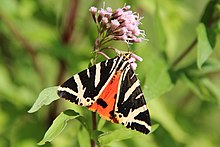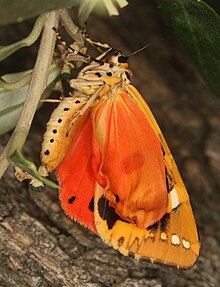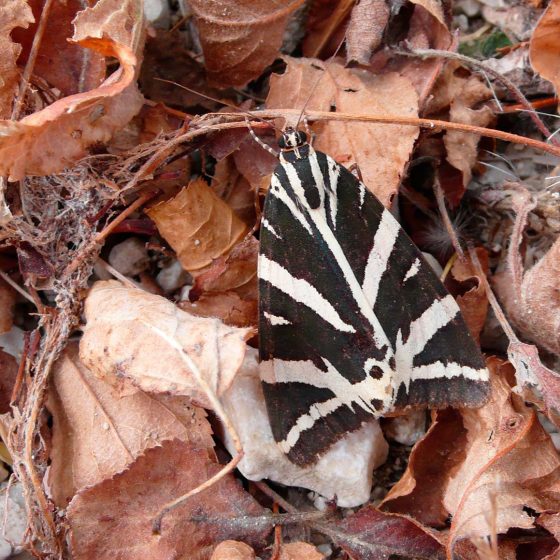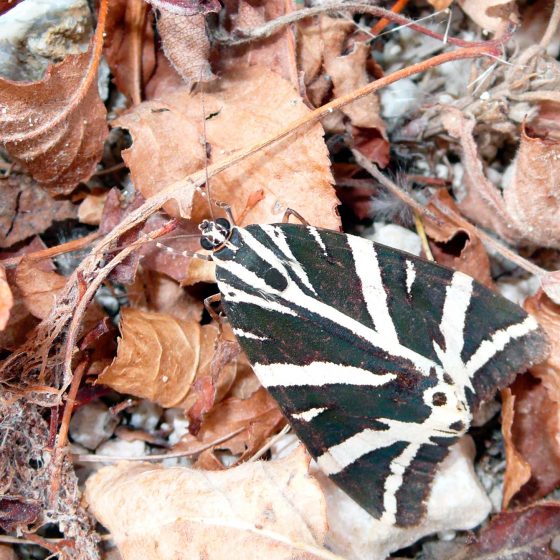Euplagia quadripunctaria – Poda, 1761
Descrizione
Farfalla della famiglia degli Erebidi.
È una falena di abitudini anche diurne, abbastanza comune; è facile incontrarla anche passeggiando lungo i sentieri nella faggeta, in generale nei boschi di latifoglie, nelle vicinanze dei torrenti ecc.
Ha una predilezione assoluta per il nettare dei fiori della canapa acquatica (Eupatorium cannabinum).
La pagina superiore delle ali anteriori presenta un caratteristico disegno bianco e nero (ben visibile nelle immagini presenti in questa pagina), quella delle ali posteriori è di colore rosso acceso con macchie nere (quattro grossi punti neri, da cui il nome specifico).
Ha una sola generazione annuale. Lo sfarfallamento avviene in estate, tra giugno e settembre.
Il bruco è scuro, con rosette spinose biancastre ed è attraversato per tutta la sua lunghezza da una striscia gialla, inconfondibile. Si nutre di noccioli, lamponi, rovi, tarassaco, Lamium (falsa ortica), Glechoma hederacea e altro ancora.
Galleria
Hipparchia fagi
 Link da Moths and Butterflies of Europe and North Africa [www.leps.it]: Euplagia quadripunctaria – Poda, 1761
Link da Moths and Butterflies of Europe and North Africa [www.leps.it]: Euplagia quadripunctaria – Poda, 1761
Contents
Euplagia quadripunctaria
| Jersey tiger | |
|---|---|

| |

| |
| Scientific classification | |
| Domain: | Eukaryota |
| Kingdom: | Animalia |
| Phylum: | Arthropoda |
| Class: | Insecta |
| Order: | Lepidoptera |
| Superfamily: | Noctuoidea |
| Family: | Erebidae |
| Subfamily: | Arctiinae |
| Genus: | Euplagia |
| Species: | E. quadripunctaria
|
| Binomial name | |
| Euplagia quadripunctaria (Poda, 1761)
| |
| Synonyms | |
| |
Euplagia quadripunctaria, the Jersey tiger, or Spanish flag, is a diurnal moth of the family Erebidae. The species was first described by Nikolaus Poda von Neuhaus in 1761. The adult wingspan is 52–65 millimetres (2.0–2.6 in), and they fly from July to September, depending on the location.[1] They tend to fly close to Eupatorium cannabinum.[2]
The larvae (caterpillars) are polyphagous, feeding from September to May on nettles (Urtica), raspberries (Rubus),[3] dandelion (Taraxacum), white deadnettle (Lamium), ground ivy (Glechoma), groundsel (Senecio), plantain (Plantago), borage (Borago), lettuce (Lactuca),[4] and hemp-agrimony (Eupratoria).[1] The insect overwinters as a small larva.[1]
Large groups of adults of subspecies E. q. rhodosensis can be found on occasion aestivating (sheltering from the summer heat) in Petaloudes, on Rhodes, in a place that has become known as the Valley of the Butterflies.[5]
Distribution
Euplagia quadripunctaria is widely distributed in Europe from Estonia and Latvia in the north to the Mediterranean coast and islands in the south.[4] It is also found in western Russia, the southern Urals, Asia Minor, Rhodes and nearby islands, the Near East, Caucasus, southern Turkmenistan, and Iran.[6] Individuals are known to migrate northwards from their regular breeding grounds during the summer.[1]
British Isles
Aside from being frequent in the Channel Islands (whence its common name comes), this species was rarely seen in the British Isles in Victorian times.[4] It was described by William Forsell Kirby as, "a great rarity in the South of England, except one locality in Devonshire."[3] Since then however it has spread more widely in Devon and Cornwall,[1] and has recently been seen more frequently in southern England, especially on the Isle of Wight, in northern Kent,[7] and south London.[8] They have been seen regularly and in numbers every year in London first discovered at Devonshire Road Nature Reserve in Forest Hill since 2004, so it is probable that they have established a breeding colony.[9]
Mothrecording.org shows a string of connected sightings on the South Kent coast from Dover to Rye in the first two decades of the twenty-first century. These are disconnected from the block of sightings in South-West England and so probably came from the Continent directly.
Subspecies
- Euplagia quadripunctaria quadripunctaria (Europe, Caucasus, Transcaucasus, northern Anatolia, northern Iran, southern Turkmenistan)
- Euplagia quadripunctaria fulgida (South Turkey, Syria, Lebanon)
- Euplagia quadripunctaria rhodosensis (Western Turkey and neighboring islands of Greece)
Conservation
This is the only lepidopteran which has been designated as a 'priority species' under Annex II of the Habitats Directive in the European Union, as of 1992,[10] which means areas in which it occurs can be declared Special Areas of Conservation.
References
- ^ a b c d e Skinner, Bernard. (1984). The Colour Identification Guide to Moths of the British Isles (Macrolepidoptera). Viking (Penguin Books), London: ISBN 0-670-80354-5
- ^ Tomozii, Bogdan; Deju, Răzvan; Cătănoiu, Sebastian (2018-01-01). "(PDF) Preliminary data on distribution of Jersey tiger moth Euplagia quadripunctaria (Poda, 1761) in the Vânători Neamț Nature Park". ResearchGate. Retrieved 2024-06-27.
- ^ a b Kirby, W. F. (1903). The Butterflies and Moths of Europe. Cassell & Co. Ltd., London: 432 pp.
- ^ a b c South, R. (1920). The Moths of the British Isles. (Series 1, Second edition), Frederick Warne & Co. Ltd., London: 359 pp.
- ^ Heath, J. & Maitland, Emmet A. (1985). The Moths and Butterflies of Great Britain and Ireland. Vol.2, Harley Books Ltd., Colchester: ISBN 0-946589-02-X
- ^ Dubatolov, V. V. (2010). "Tiger-moths of Eurasia (Lepidoptera, Arctiidae) (Nyctemerini by Rob de Vos & Vladimir V. Dubatolov)". Neue Entomologische Nachrichten. 65: 1-106
- ^ Ferguson, I. D. (2009). Kent Moth Report 2005. Butterfly Conservation, Kent Branch: 56 pp. Archived 2014-08-21 at the Wayback Machine
- ^ "Sightings of Jersey tiger in Orpington, August 2012". RSPB.org also in Streatham, London, in July 2014.
- ^ Jersey tigers on UK Safari page
- ^ "Council Directive 92/43/EEC of 21 May 1992 on the conservation of natural habitats and of wild fauna and flora". Eur-Lex. Retrieved 22 September 2020.
Further reading
- Roesler, U. (1968). "Panaxia quadripunctaria ssp. ingridae ssp. nov. (Lepidoptera, Arctiidae)". Entomologische Zeitschrift. 78 (24): 280–284, Stuttgart.
External links
- Kimber, Ian. "72.030 BF2067 Jersey Tiger Euplagia quadripunctaria (Poda, 1761)". UKMoths. Retrieved 23 August 2019.
- Butterfly Conservation: Saving butterflies, moths and our environment
- Fauna Europaea
- Lepiforum e.V.
- De Vlinderstichting (in Dutch)
- Videos about the Jersey tiger: [1] and [2]





